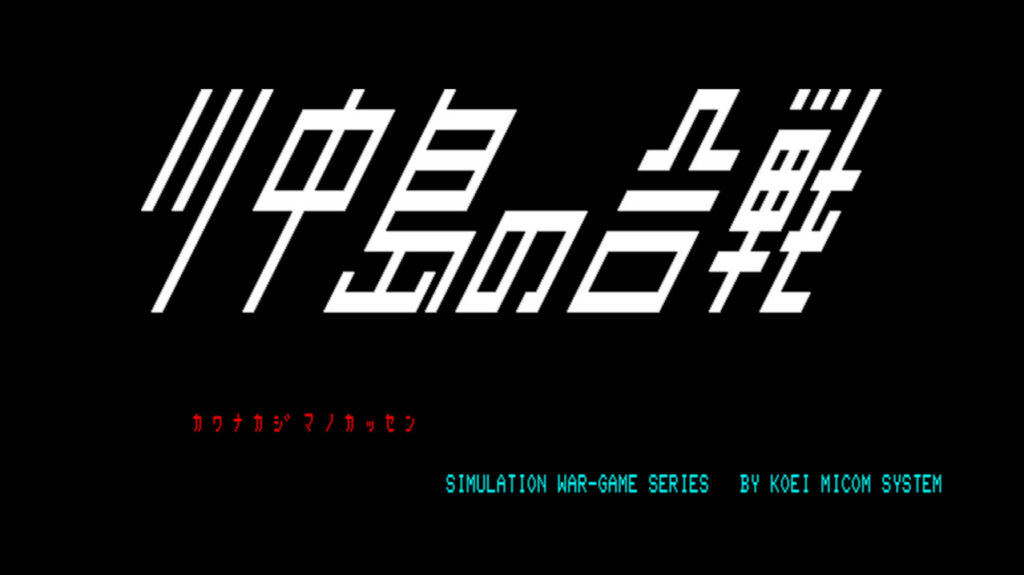
They are retreating ! Order our Guard to march forward, and let’s destroy the Uesugi clan right now!
I apologize profusely, Takeda-dono. All members of the Guard have been buried waist-down and cannot move !
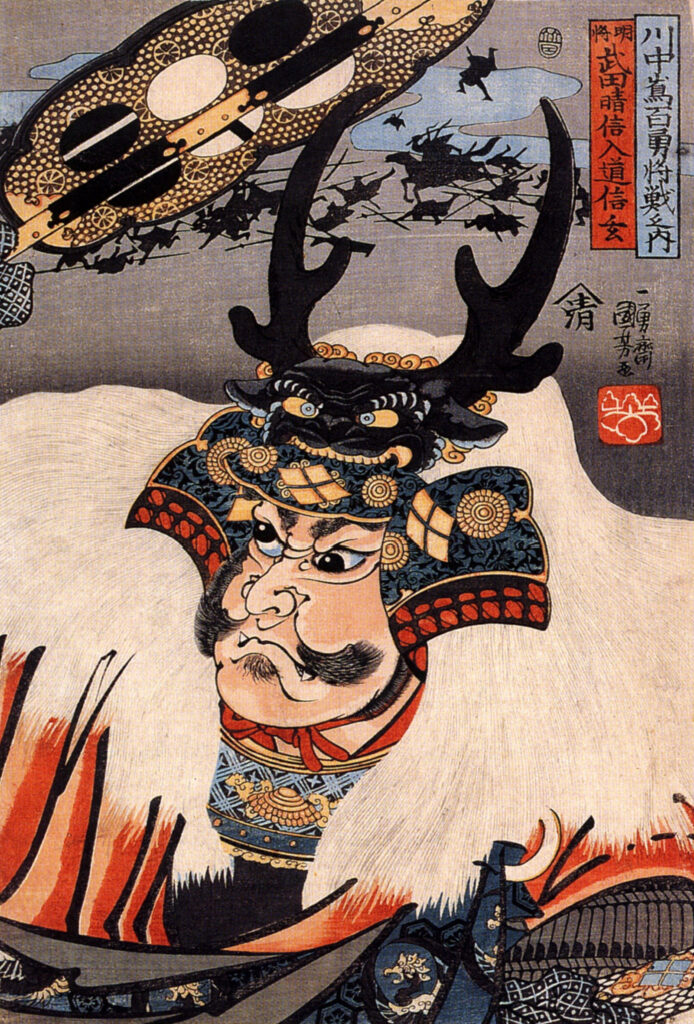
Kawanakajima no Kassen (the Battle of Kawanakajima) is the earliest Japanese computer wargame I could find, though keep in mind I do not speak Japanese and must rely on incomplete English documentation – I am sure some of you will send me earlier wargames.
I must shamefully admit I had never heard of the battle of Kawanakajima before playing this game, but then my knowledge of the Sengoku period is limited to a few grand strategy games and Kurosawa movies. In September 1561, at Kawanakajima (near modern-day Nagano), Takeda Shingen (the character from Kagemusha) tries to trap and destroy the army of his rival Uesugi Kenshin in one of the most iconic – and bloodiest – battles of the era. In Kawanakajima no Kassen, you are given control of Takeda’s army, and will try to perform better than historically.
The game opens with Takeda’s army nicely deployed on the battlefield :
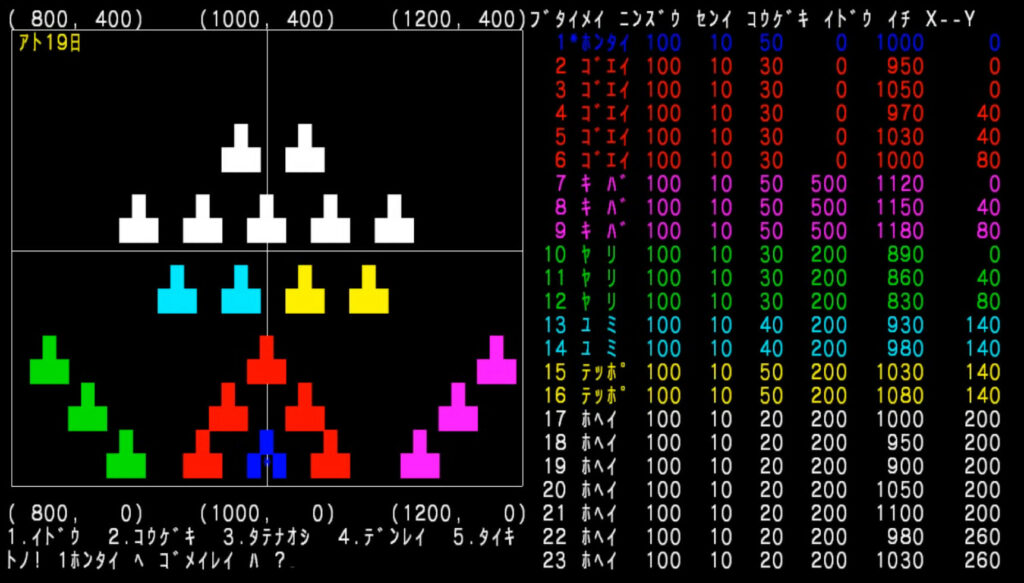
It is at this point that I should thank commenter Helly for translating a version of the game just for me. I did not do the AAR on that version (more on that below), but it allowed me to understand the game, so here is the initial screen that I edited with his English translation :
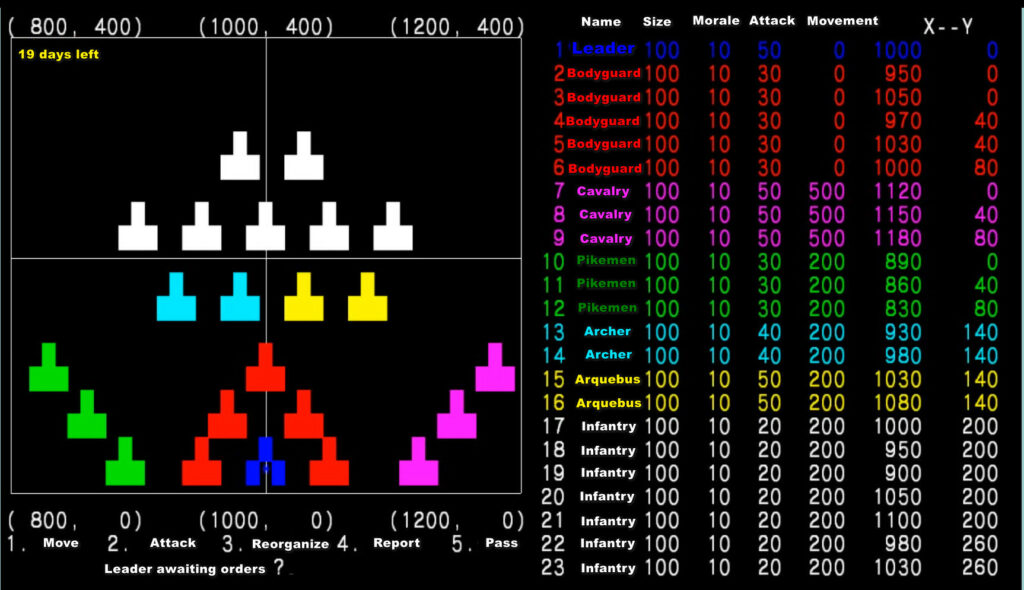
The battlefield is a square of size 2000 x 2000. My leader occupies the South of the battlefield, he cannot move and is surrounded by his bodyguards who cannot move either. The rest of the army can move at 200 distance units by turn, except the cavalry which can move at 500. Uesugi occupies the North of the battlefield, and his army is exactly symmetric to mine. My objective is to kill Uesugi in less than 20 turns / days.
I know Uesugi will send everything he has at me – except the bodyguards, of course. It takes 10 turns to cross the battlefield, so if I wait for his attack then counter-attack I will lose on the timer. My plan is to send a murder party on my right, while keeping a defensive position with everything else. For my murder party, I choose my cavalry and all my ranged units – bowmen and arquebusiers. It will take them around 12 or 13 turns to reach the enemy, but once they arrive they should be able to kill Uesugi quickly. Meanwhile, waiting for the enemy, my infantry falls back into a line, bolstered by my pikemen (in game terms, pikemen are just stronger infantry).
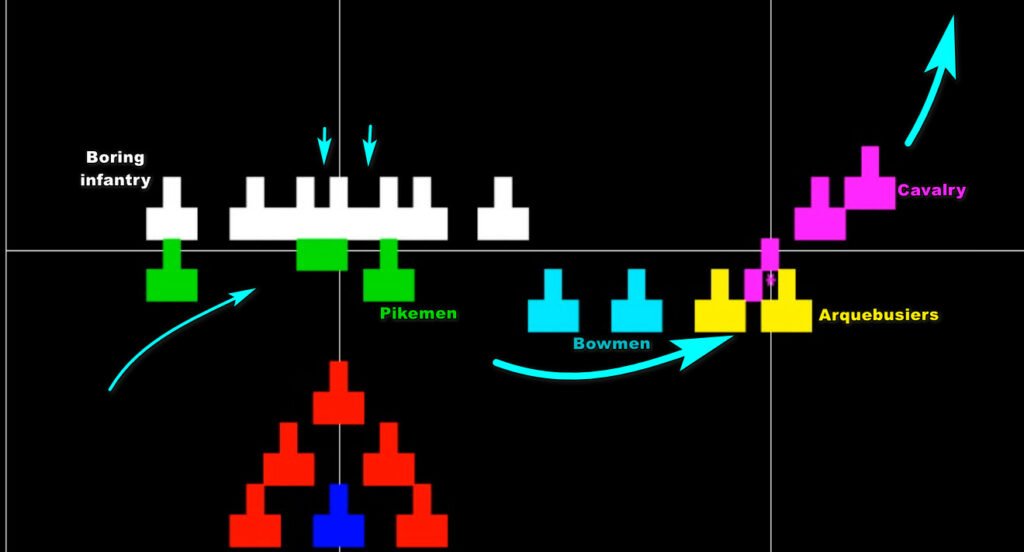
I spend the following turn abusing the lack of stacking rules to create doom stacks.
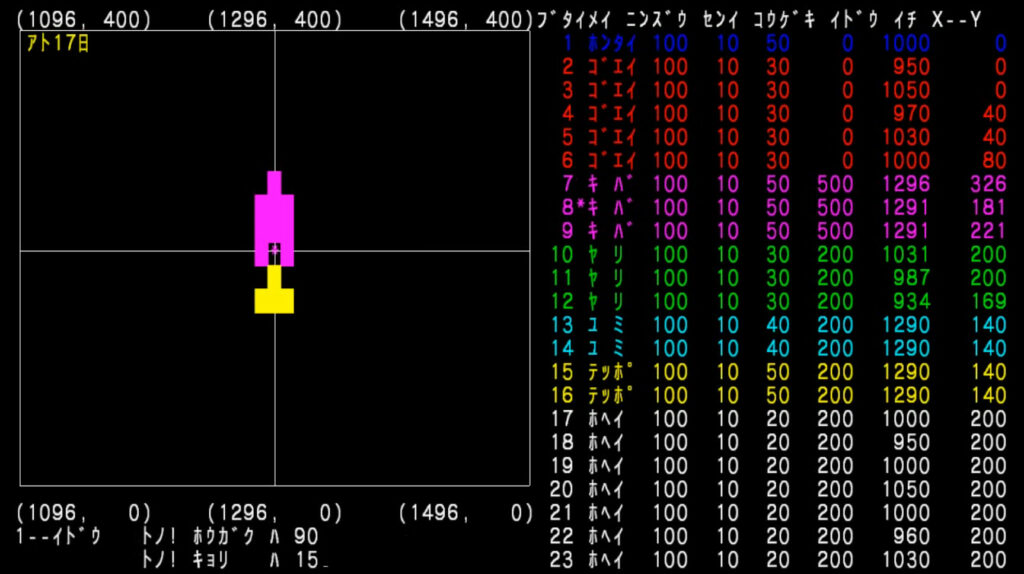
I’m not able to finish my defensive doom stack before the enemy cavalry approaches ! Well, that was fast – they did not wait for their infantry.
My defensive formation tries to attack Uesugi’s horsemen (all units have at least some range), but they are too far away to be attacked efficiently, and, well, my real ranged units are not there.
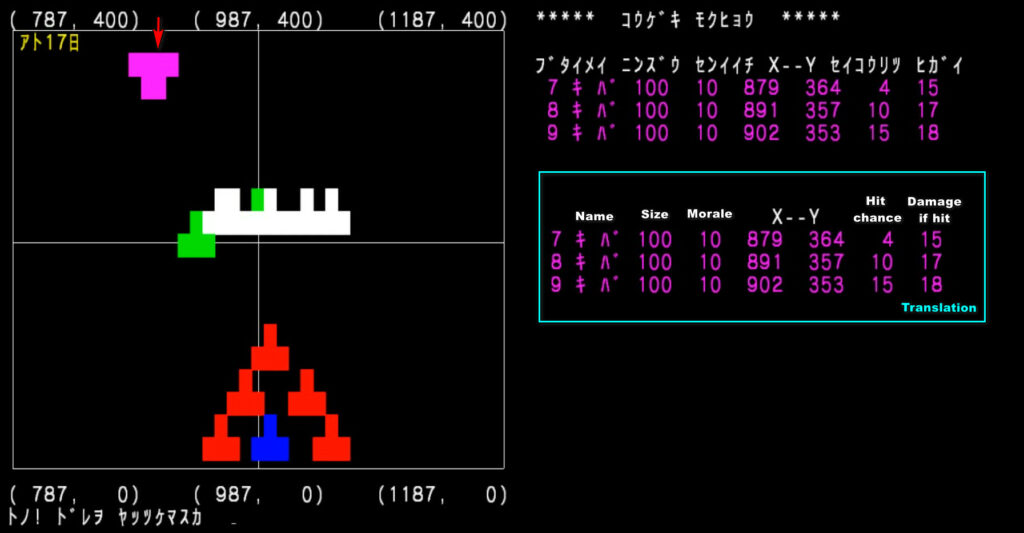
I cannot attack efficiently, and as long as AI units are in range they will also try to attack even inefficiently, which would be OK with me if the rest of Uesugi’s clan was not on its way. For this reason, I fall back somewhat to entice the cavalry to move in a more vulnerable position.
The plan works perfectly – almost too well – and the enemy cavalry jumps right in the middle of the bodyguards, next to Takeda.
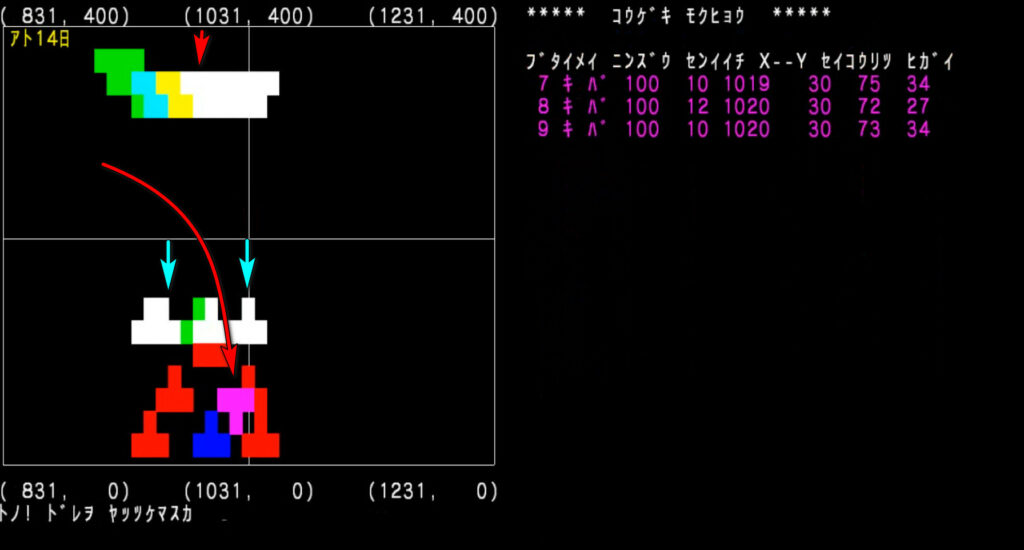
Unfortunately for them, units cannot move and attack, and units play in sequence : first my leader then their leader, then my bodyguards then their bodyguards,… This means that before Uesugi’s cavalry can attack again, every single of my units in the area can attack them once. I destroy 2 of the 3 cavalry units.
Just in time, because the rest of Uesugi’s army is there, and his foot soldiers try to leap in range of my commander. As more and more hostiles approach my commander, I realize I won’t be able to kill them all before they get to play their turn and try to kill my commander…
… but I have an easy solution. I move one of my infantry forward, and now all the enemy units that have not played have something in range to kill, and they stop advancing !
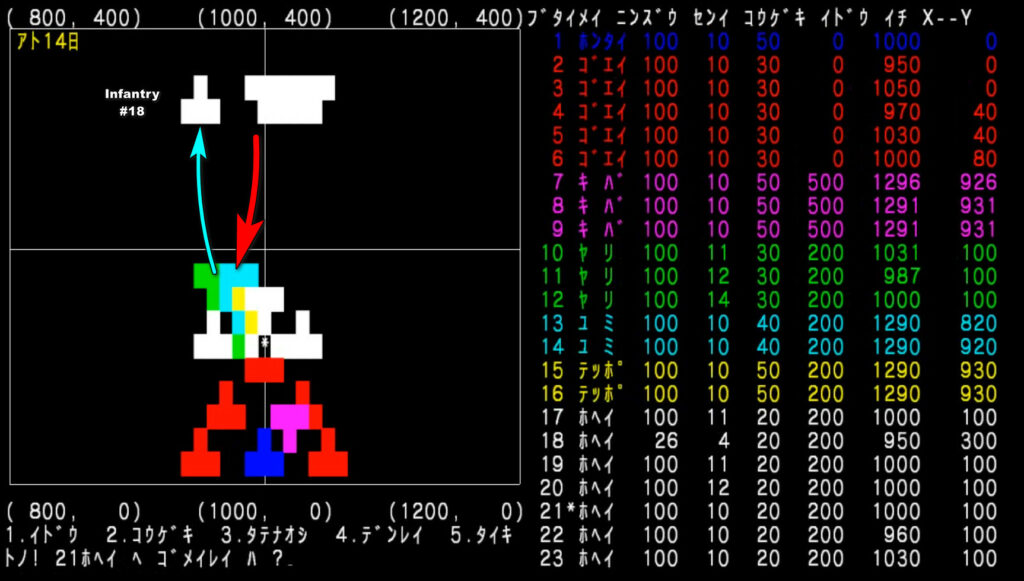
With this neat trick, I wipe out the first half of the enemy force, while my leader is only hit once, for 8 damage. I then advance to kill the rest of them.
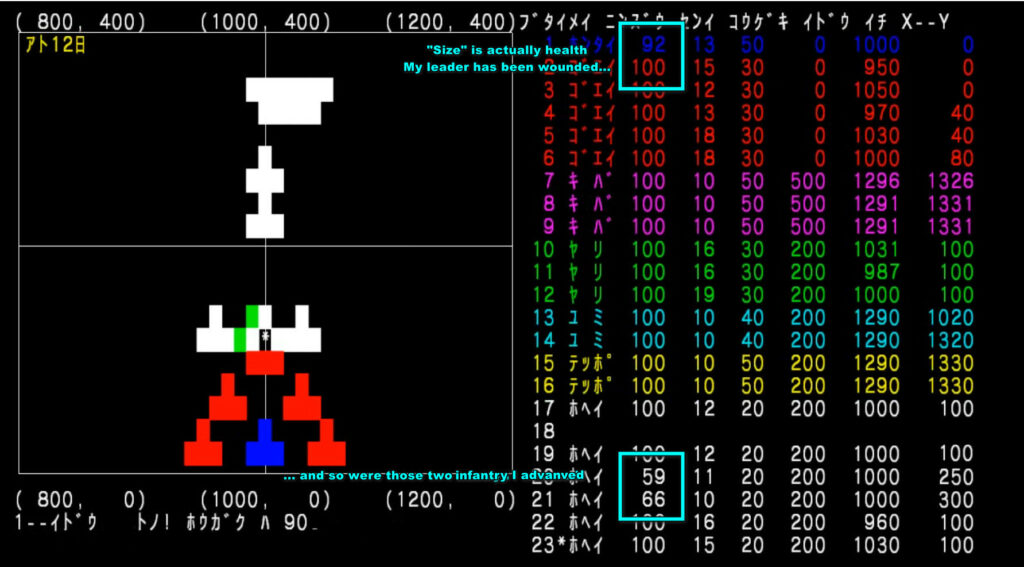
Finishing the rearguard takes more time because I advanced out of range of the bodyguards, and because one of the enemy units has very high morale due to destroying unit #18 :
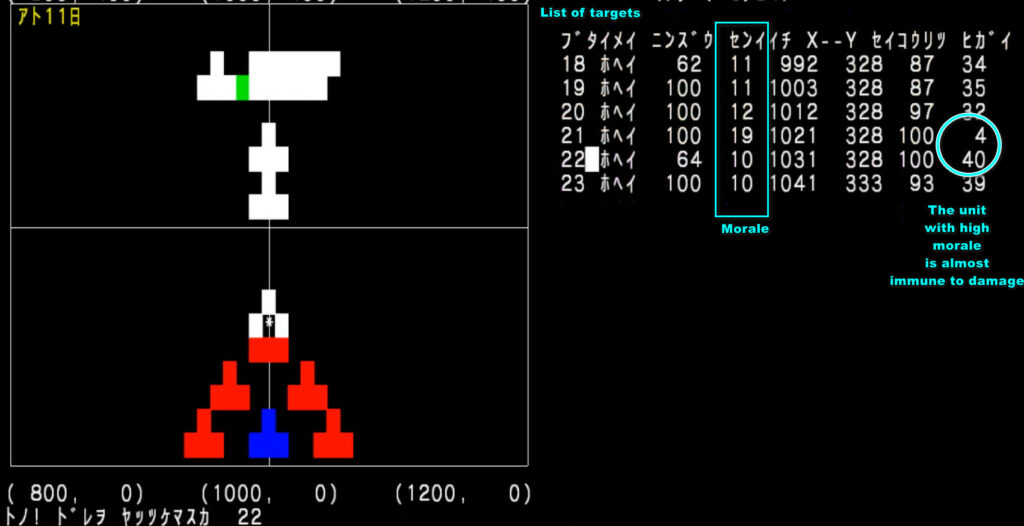
Still, every time a unit is hit, it loses 1 morale, and once its morale dropped, I destroy it like the others.
The annihilation of the second wave has become irrelevant anyway, because the fate of the battle is now in the hands of my murder party which finally arrived in range of its target.
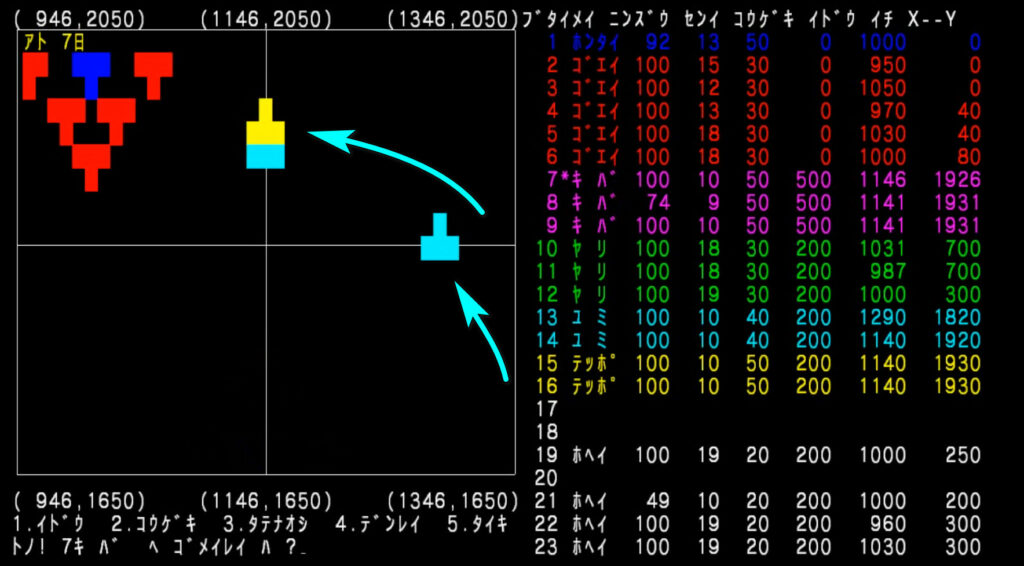
I started to pick off the bodyguards while remaining a bit far away :
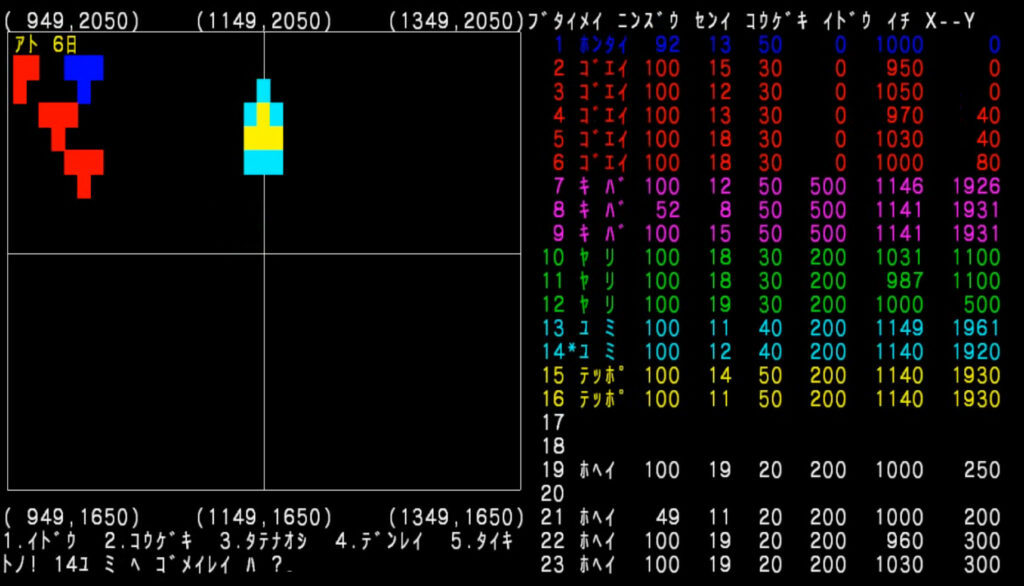
Once I destroyed the two closest bodyguard units, it is time to target Uesugi ! This is the last turn :
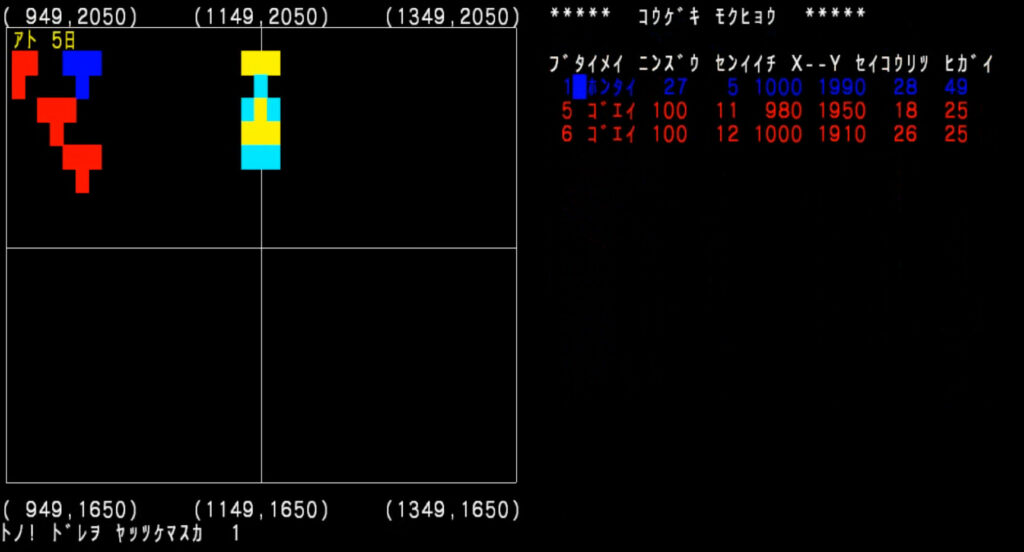
I think this screen says I won :

Review and Ratings
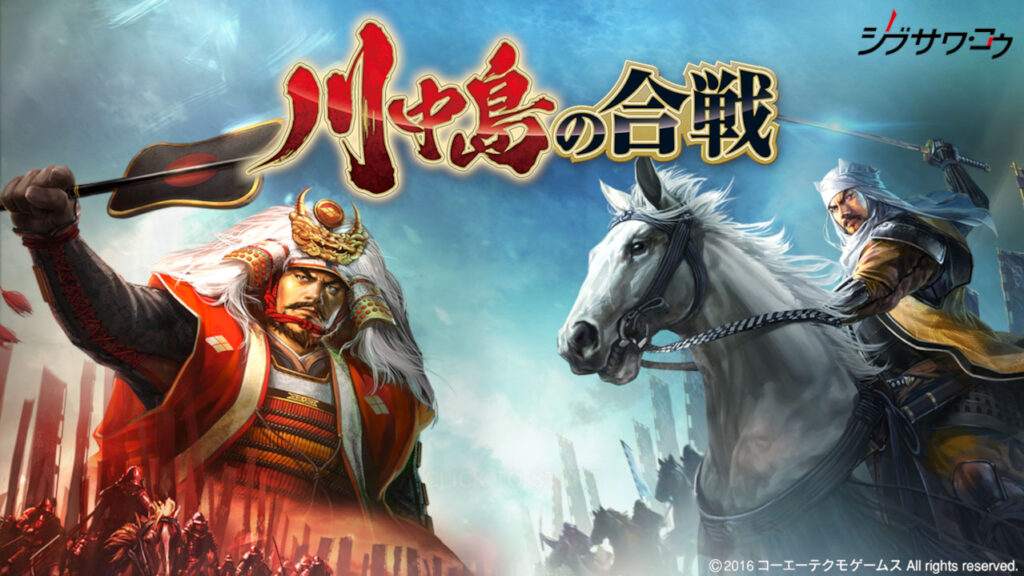
Kawanakajima no Kassen by Yoichi Erikawa (aka Kou Shibusawa), Japan, published by Koei
First release: October 1981 on MZ-80C
Tested on : PC-88 emulator, Steam
Total time tested : 4 hours (+1 hour 2016 remaster)
Average duration of a battle: 40 minutes
Complexity: Easy (1/5)
Would recommend to a modern player : No
Would recommend to a designer : No
Final Rating: Totally obsolete
In 1978, a 28 year-old man called Yoichi Erikawa pledged to save his father’s fledging dye & chemical wholesale business with his wife Keiko. Recreating his father’s commercial venture under the name Koey in July 1978, the Erikawa struggled in a context where more and more textile was being produced and imported from outside of Japan. In October 1980, Keiko gifted Yoichi a MZ-80C computer, an expensive present. The computer fascinated Yoichi, who immediately learned BASIC and Assembler, and then wrote software : a first one to help him manage the business’ inventory, another for their finances. In truth, the limited complexity of their operations did not require any computer but eh – it was fun to code. Still, the software attracted some interest from larger companies, and soon Koey was selling business software. Seeing the potential of the booming personal computer market, Yoichi also started a computer shop in addition to his initial venture as a chemical wholesaler. With the little personal time he had left, Yoichi Erikawa started – as a hobby really – to code a small wargame on his computer, something simple given the limitation of the MZ-80C and of his own skill as a coder : Kawanakajima no Kassen, Keiko handling the art on the box and in the manual. On the 26th of October 1981, Erikawa put the first ads in magazines – the first Japanese computer wargame was released.
Sadly, I don’t know much about the different versions of Kawanakajima no Kassen. As I indicated, I initially tested with a translated PC-88 version but that version was not very stable, even though I could complete some sessions. I ended up doing my AAR on the original Japanese version provided with the 2016 Steam remaster of the game. That “original” Japanese version was either actually from an improved version, from say 1983 or 1984, or not so original after all, since there are at least two differences with the PC-88 version :
- In the PC-88 version, updating the map around one of your units is an action just like attacking or moving, so it ends your turn – an absolutely maddening “feature”,
- In the PC-88 version, there is only one level of difficulty, whereas there are 10 levels of difficulty in the version I played (from 0 to 9, each “level” is giving 10 extra HP to all AI units).
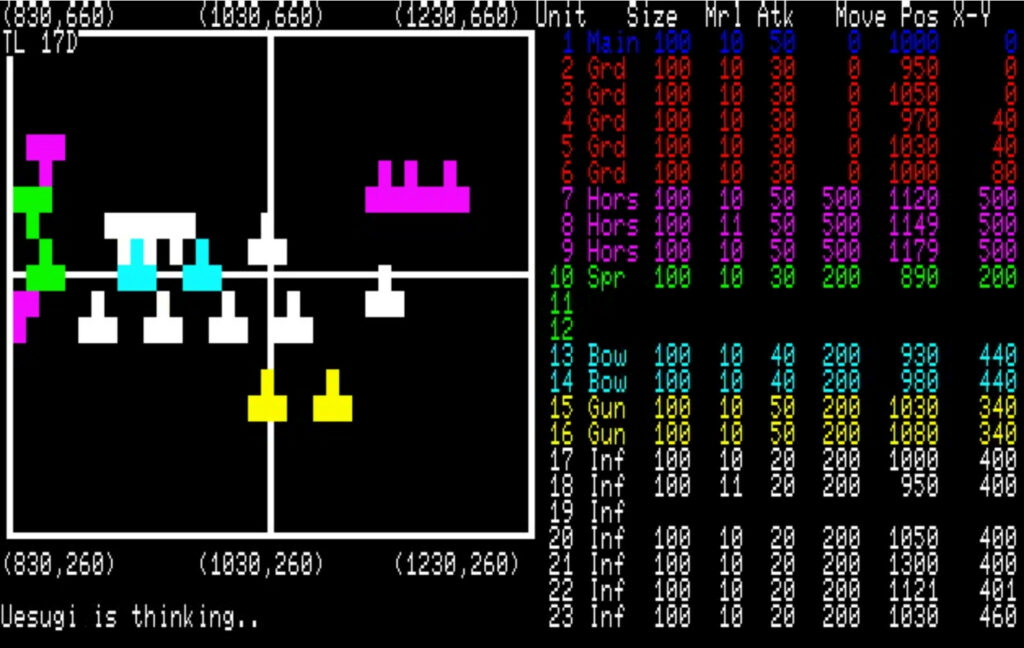
The remaster itself is pretty sweet, and I find it interesting to see how a game that simple could be modernized 35 years later. I will show the changes in the remaster as I go through the categories, though the rating is for the original version.
A. Immersion
No immersion at all. The game has no real graphics, and the battle has very little to do with the historical battle of Kawanakajima except for the name of the leaders, both armies are perfectly symmetric and the game does not feel realistic at all – as I showed all units can occupy exactly the same location, in one blob of death.
Rating : Terrible
Obviously, the new version has functional graphics and nice RPG-ish music. In addition to this, each non-infantry has its own commander with a portrait coming from a recent Nobunaga’s Ambition iteration. Of course, the units can still stack on top of each other, so the suspension of disbelief does not last.
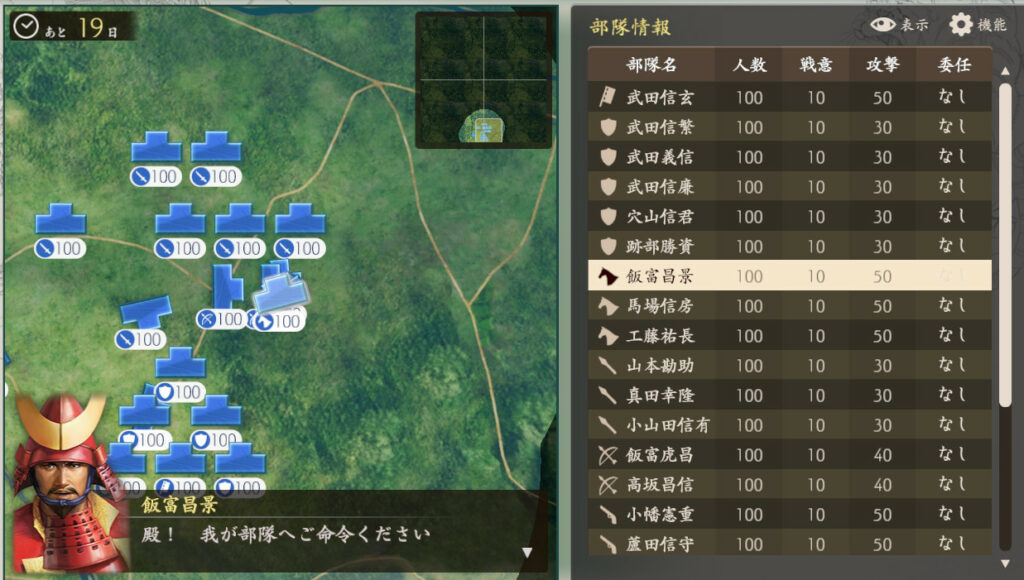
B. UI , Clarity of rules and outcomes
Disclaimer : I could not source the 1981 manual, but even the 2016 manual is lackluster : no information on morale, very little information on range,…
I only have bad things to say about the PC-88 version rule that requires you to spend one action to check what’s happening around a unit. Even on the version I played, the view is not updated as long as you don’t call the “report” command, and it only updates for the active unit (so no chance to check what the cavalry you just sent forward can see). In addition, the view is way too zoomed in (you only see a distance of 200 around your unit).
Moving units around in itself is not always trivial: you need to input a direction and a distance. It is fine when moving horizontally or vertically, but if you want to move in diagonal and reach a spot neither too close nor too far from the enemy, prepare to do some trigonometry.
Rating : Terrible
The remake is a real pleasure to play, with a drag-and-drop interface, a mini-map, an easy way to check units or to pan the map and see what your units can see. In one word : a modern game.
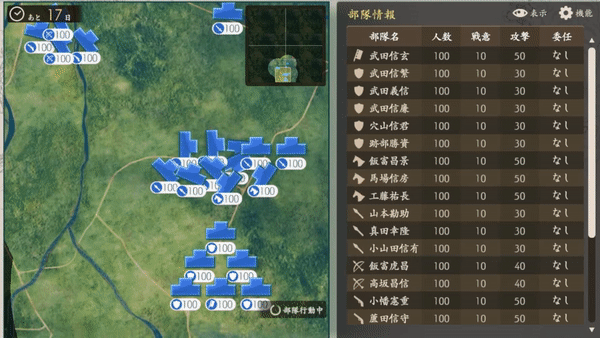
Of course, good luck checking the status of individual units in the situation below :
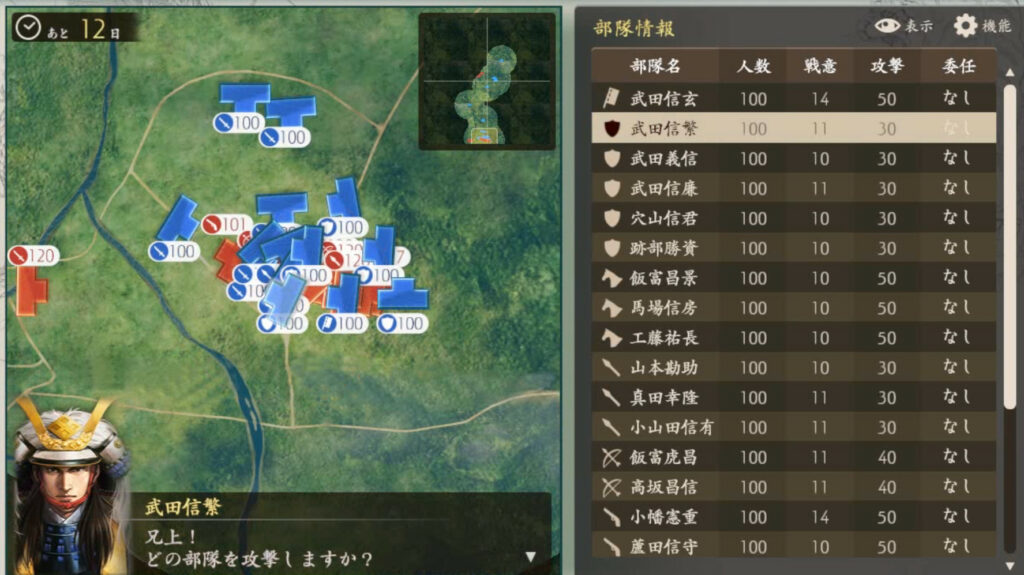
C. Systems
It is fairly simple. Units are called one after the other and can either move, attack, rally or, in the PC-88 version, report what is around them. If you lose a unit (say unit #7), then your opponent will play units #6 and #7 one after the other before you can play unit #8.
Attacks have a range, and both chance-to-hit and damage decrease when the target is further away. Another modifier is the type of unit : cavalry and leaders have 50 in base attack, arquebusiers 40, bowmen, pikemen and bodyguards 30, and standard infantry only 20. At close range, it is not rare for a cavalry unit to have 100% chance to hit and inflict 65+ damage.
The last factor is morale. Morale impacts the damage caused or received, though not chance-to-hit (it seems). Morale goes up by 1 every time a unit hits another, by 3 every time a unit destroys another, and decrease by 1 every time a unit is hit. Finally, a unit can spend one turn to rally, moving its morale back to 10. Given you cannot heal a unit, by the time morale is so low it is worth to rally, the unit is probably about to die anyway.
Overall, the system could have been mighty fine… but the lack of stacking rules mean you should just create a doomstack that kills everything that approaches it – there is no manoeuvring in this game, and so, no tactics.
Rating : Very poor
I don’t see differences in the remake, except maybe that the view range is higher.
D. Scenario design & Balancing
There is only one scenario, and the only impact of the difficulty slider is how much HP the AI units have. The AI is perfectly predictable, and I beat the game consistently.
Rating : Very poor
In the remake, the AI is significantly smarter : it uses its cavalry (and their extended view range compared to the original) to patrol the battlefield and scout your forces, with even a small reaction kept aside to intercept your murder party. Meanwhile, the bulk of the enemy force will try to assassinate your general, but it will not always attack from the front.
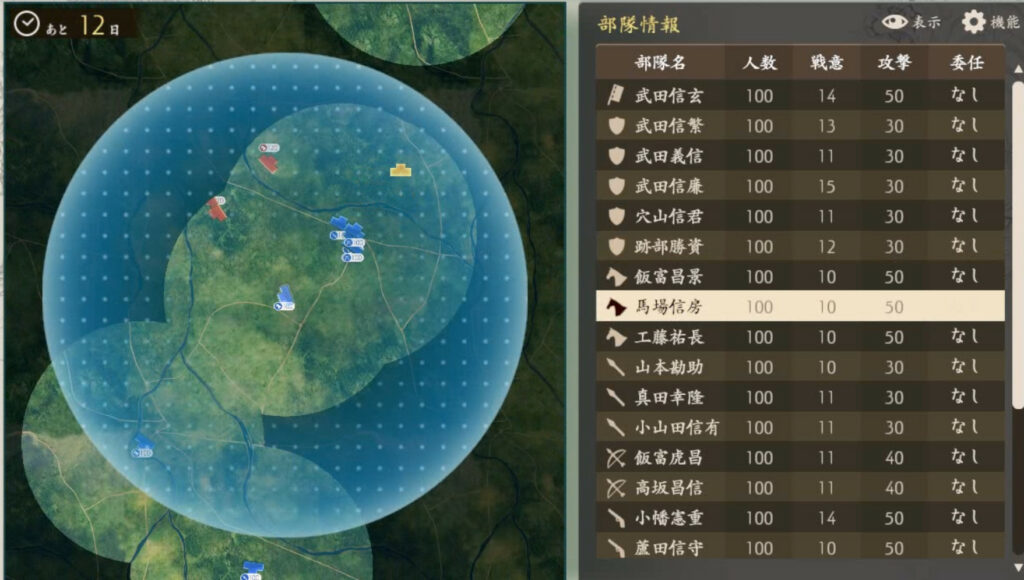
The remake also offers an option to randomize the starting stats (in HP and morale) of your units, or to give each unit’s stats depending on their general – an option that probably makes more sense if you are familiar with Nobunaga’s Ambition.
E. Did I make interesting decisions ?
No. The most interesting decision you will take, both in the original and in the remake, is how to split your defence and your attack, and how to prioritize your targets.
F. Final rating
Totally obsolete.
The remake is a decent beer & pretzel game, but at 13 € it is way overpriced for one scenario. It is worth a check if you really don’t care about money, or if you can get it as part of a bundle.
Contemporary Reviews
I am not even going to even try to cover contemporary reviews in Japanese. Suffice to say that Yoichi Erikawa expected to sell a few dozens of copies, one-hundred at best, but he sold 10 000 copies, generating more than the annual revenue of his struggling dye & chemicals business. Kawanakajima no Kassen was pivotal in turning Koey (soon redubbed Koei) into a software company. After a couple of erotic games the Erikawa don’t like to talk about and don’t usually mention in their interviews, Koei released its first RPG : the Dragon & Princess, and finally in 1983 the first iteration of its iconic Nobunaga’s Ambition – a strategy game I am looking forward to play, given its stellar reputation.
Small note : Joel Billings told me that Epidemic was really released in January 1983, even though it was planned for (and maybe sent to reviewers in) December 1982 – I updated the article.
3 Comments
One thing I find kind of baffling is the cover art attributed to this game.
https://koei.fandom.com/wiki/Kawanakajima_no_Kassen
That imagery is clearly not of the Sengoku period. What exactly are we looking at here?
There seem to be two dumped copies in the Neo Kobe archives:
“Kawanakajima no Kassen.d88” – Appears to be a PC-8801-compatible disk image, though I could be quite mistaken. Japanese computer emulation is pretty mysterious.
“Kawanakajima no Kassen.n80” – Appears to be a PC-8001-compatible tape image. Again, I could be very wrong. Once loaded, I see no differences between it and the d88 version.
I gather the original MZ-80C version is lost. And I think it’s unlikely that the PC-88 got an “improved” version with the enhancements seen in the 2016 Steam release – if that did happen, its undumped status means that it somehow failed to gain wider distribution than the original that came out before Koei made a name for itself. It seems more likely that these things were added in 2016, along with the anti-aliased fonts and thinner grid lines.
About the Falkland War cover for the Sengoku game, Keiko explains it here but Google translate does not give me anything clear :
https://news-denfaminicogamer-jp.translate.goog/projectbook/koei?_x_tr_sl=auto&_x_tr_tl=en&_x_tr_hl=fr&_x_tr_pto=op,wapp
About the versions, maybe the “checking around your unit does not take one turn” is a new addition. It is a blessing then, fighting blind would have made a terrible AAR (“all those units you see have been killed two turns ago, but I had no opportunity to update my screen”). The murder party can be navigated blindly, since the coordinates of Uesugi and his bodyguards never change.
Heh. I had heard of these games that existed even before computers could display Japanese characters. The simple characters used in this game only represent sounds. I read an account of a man who had to pronounce all the sounds aloud so that he could understand them. If he only read them, he didn’t “understand” them. Strange, eh?
It’s also amazing how many of these old games got remakes. Sometimes the game was pretty obscure but someone loved it enough to remake it. Sometimes that person is the creator. Sometimes the remake was in 2002, or 2009, or 2012, or surprisingly long ago. I wondered why this one got remade, it seems pretty forgettable. Then – oh, it’s by Koei. His wife is a pretty good artist.